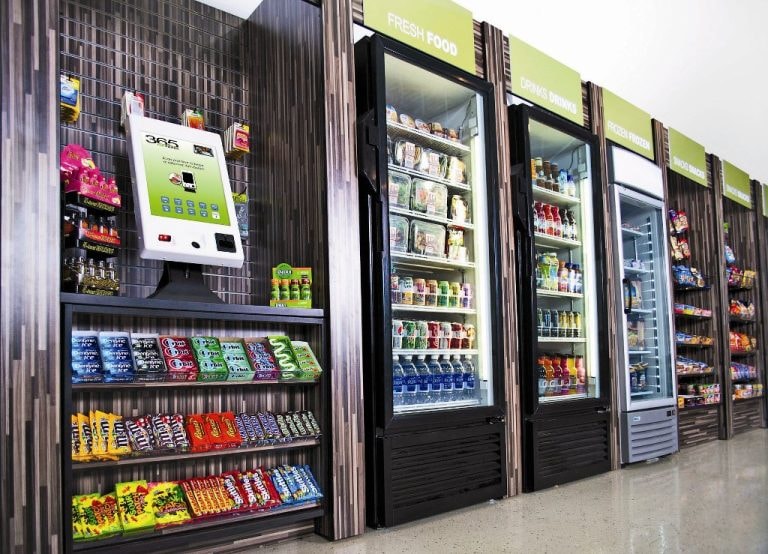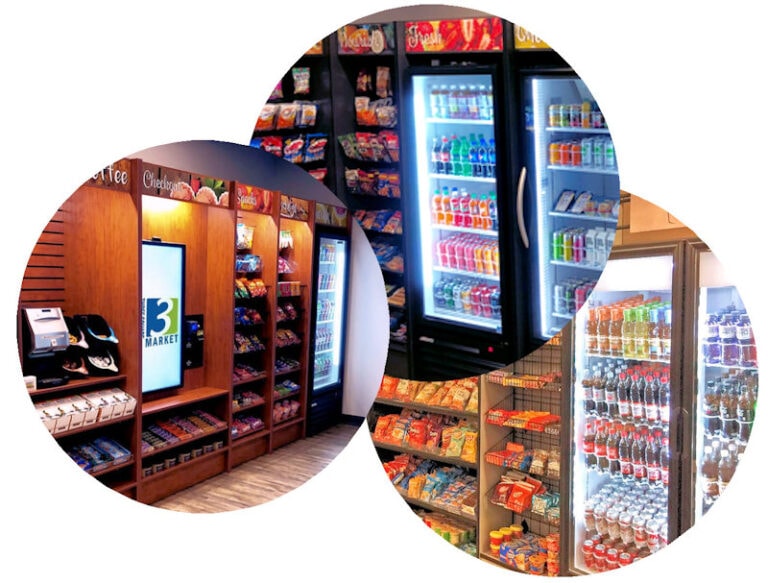
For decades, we’ve associated the vending industry with coins clinking into machines, buttons being pressed for a cold drink and an occasional snack getting stuck in its spiral cradle. Traditional vending machines have served us well in breakrooms, airports, gyms and public spaces. But in 2025, a quiet revolution has taken place: the rise of the micro market solution.
As consumer preferences evolve and workplaces modernise, many business owners, facility managers, and property developers are asking: Is it time to move beyond vending machines? And more importantly, what makes the micro market kiosk different—and better?
In this blog post, we’ll walk you through the differences between micro markets and traditional vending machines, how each one works, what they cost, how they perform and which one is right for your business.
Understanding the Evolution: From Push Buttons to Open Markets
To understand what micro markets bring to the table, you need to understand where they came from.
Traditional vending machines are automated units stocked with snacks, beverages and other packaged goods. Customers insert money or tap their card, make a selection and receive a product through a small compartment. It’s a reliable, closed-loop system designed for quick, low-effort transactions.
Micro markets are a completely different animal. Imagine an unmanned convenience store built into your workplace —open shelving, refrigerated displays and self-service kiosks. Instead of peering into a glass panel and pressing a button, customers can physically browse products, pick up fresh meals and pay at a digital kiosk using a card or mobile wallet.
Coffee machines are often integrated into micro markets as a modern, space-efficient alternative to traditional kitchen appliances, complementing other technologies like smart fridges and vending machines.
It’s vending reimagined for modern expectations.
How Micro Markets Work

Micro markets work by providing a self-service kiosk where employees can browse and purchase products using a variety of payment options, including credit/debit cards, cash, and payroll deduction. The kiosk is connected to a secure network, ensuring that all transactions are safe and stable.
Employees can select from a wide range of products, including fresh food, hot and cold drinks, and healthy snacks. Once a selection is made, the employee can pay for the product using their preferred payment method. Micro markets are designed to be easy to use and navigate, making them a convenient and secure way for employees to purchase food and beverages at work.
Micro market solution includes loyalty programs and offers meal deals. Micro markets offer a personalised experience for each employee.
What Makes Micro Markets So Different?

At its core, a micro market turns a passive snack station into a mini retail space. There’s no glass barrier between the customer and the product. People can read nutritional information, feel the weight of a bottle of juice or choose from a row of snacks.
This setup naturally invites higher engagement. Where a vending machine might serve a quick cold drink and a snack, a micro market can serve entire meal routines—breakfast smoothies, lunchtime bowls, afternoon protein bars, even barista-style canned coffee.
These markets provide a diverse range of food and beverage options, enhancing workplace environments by offering convenient access to healthy choices. And because the payment process is handled through a self-checkout system—either a touchscreen kiosk or a mobile app—there’s no need for cash handling or staffing. The vending business is frictionless, modern and remarkably scalable.
Cost and Setup: What’s the Investment?
The financial aspect is where many businesses start comparing micro markets and vending machines. And it’s true—the startup costs for micro markets are higher. Between installing kiosks, branded shelving, refrigerated units and security systems, the average investment for a single micro market ranges from £10,000 to £25,000.
Essential equipment, such as vending machines and coffee machines, is crucial for effective space utilisation in micro markets, ensuring an efficient and cost-saving food service solution for businesses.
But those numbers don’t tell the full story.
Vending machines may seem cheaper upfront (typically GBP 2,000 to GBP 8,000 per unit), but they’re limited in what they can offer. You’re confined to items that fit specific slots or coils. Fresh food? Unlikely. Artisan drinks? Only if they’re in cans or bottles. And forget any meaningful in-store experience.
Micro markets allow for broader product variety, which in turn increases average purchase value. While the typical vending transaction is around £1.50 to £2.50, micro market customers spend an average of £4 to £6 per visit. Over time, this higher basket size contributes to a faster return on investment, especially in high-traffic or employee-heavy environments.
Installation and Maintenance
The installation and maintenance of micro markets are straightforward and hassle-free. Our expert team will work with you to design and install a micro market that meets your specific needs and available space. We will provide regular restocking and maintenance of the micro market, ensuring that it is always fully stocked and functioning properly.
Our micro markets are designed to be secure and stable, with all transactions taking place through a secure network. We also offer a variety of payment options, including credit/debit cards, cash, and payroll deduction, making it easy for employees to purchase products.
With our latest technology and support package, you can trust that your micro market will always be running smoothly and efficiently.
Where Each System Works Best
Vending machines have long thrived in public spaces: transport hubs, universities, gyms and hotel lobbies. They require minimal space, can operate independently for days and are fairly vandal-proof. If you’re serving transient traffic or open-access areas, vending still holds a strong case.
Micro markets are ideal for semi-private environments—corporate offices, warehouses, coworking spaces, hospitals or apartment communities. They require slightly more room (at least 40 to 100 square feet), a secure or monitored setting and a consistent user base. But what they offer in return is transformative: a sense of convenience, trust and personalisation that vending machines simply can’t replicate.
Integrating micro markets into office environments can significantly enhance employee well-being and company culture. These setups provide easy access to quality refreshments, promoting a modern alternative to traditional break rooms and creating a more enjoyable workplace atmosphere.
One trend we’re seeing in 2025 is companies using micro markets as part of their workplace wellness strategy. Providing fresh, healthy food and workplace refreshments onsite not only boosts morale but can also improve employee productivity and retention. When paired with loyalty programs and app-based promotions, micro markets become more than a refreshment solution—they become an extension of the employer brand.
Behind the Scenes: Inventory and Technology
Traditional vending machines often require manual inventory checks or basic telemetry systems. If a coil jams or a product sells out, you may not find out until a customer complains. Restocking routes must be planned efficiently, often with limited data.
Micro markets, on the other hand, run on cloud-based inventory systems. Every sale is tracked in real-time, allowing operators to view stock levels, sales trends and expiration dates from a central dashboard, a perfect blend of technology and convenience. This makes inventory replenishment smarter, faster and less wasteful. It is crucial to maintain these systems to ensure the ongoing operation and management of micro markets, providing a seamless experience for users.
Many operators also integrate AI-driven analytics to forecast product demand, rotate slow-moving SKUs or recommend new items based on customer behaviour. It’s the kind of operational intelligence vending machines rarely provide—unless heavily upgraded.
Payment Options and User Experience
Customer expectations in 2025 revolve around three things: speed, ease and flexibility. Both vending machines and micro markets now support contactless payments, but that’s where their similarity ends.
Vending machines typically offer a limited purchase journey. Choose a product, pay, and retrieve the item. There’s no option to view product ingredients, combine items into a bundle or apply loyalty discounts. And while digital touchscreens are improving, they still pale in comparison to the interactivity of a kiosk or app.
Micro markets allow customers to scan multiple items in one transaction, apply promo codes and even earn points. The self-checkout kiosk enhances the shopping experience by streamlining operations, offering a variety of payment options, and allowing customers to interact seamlessly with the system. Advanced setups can send push notifications about discounts or restocks, further encouraging return visits.
In short, micromarkets offer a shopping experience. Vending machines offer a transaction.
Security and Theft: A Common Concern
One of the most common hesitations with micro markets is the lack of physical barriers. With open shelving, how do you prevent theft?
The answer lies in a combination of smart placement, surveillance and design psychology. We are now looking at AI and cameras within smart fridges to reduce the shrinkage element.
In addition to security, food safety is a critical concern in micro markets. Advanced cleaning technologies and self-locking mechanisms prevent the sale of expired products, enhancing health standards and reducing contamination risks.
Most micro markets are placed in semi-private environments with limited foot traffic from the general public. CCTV systems are installed at eye level and integrated with the kiosk timestamp. In some setups, users must scan a badge or QR code to enter the area, adding traceability.
Studies show that when clear signage, camera visibility and community responsibility are communicated effectively, shrinkage is below 2%. Compare that with losses from traditional retail stores, and micro markets fare surprisingly well.
Vending machines, by contrast, are less susceptible to theft but more prone to vandalism, especially in outdoor or unsupervised locations. It’s a trade-off that depends heavily on your site environment.## Sustainability and Brand Image
Fulfilling Your ESG Goals
In 2025, sustainability isn’t just a buzzword—it’s a business requirement. Consumers are choosing brands and services that align with their values.
Micro markets fit nicely into this narrative. They support fresh products so operators can curate better-for-you product lines. Some markets even partner with eco-friendly vendors or reduce waste through reusable packaging.
Businesses can also use the self-checkout interface to communicate ESG goals(Environmental, Social and Governance) or promote green initiatives. It’s a subtle but powerful way to marry convenience with consciousness.
Traditional vending machines are improving, but still have challenges. Limited packaging types, smaller supplier networks and higher energy use in some older models make them less flexible in promoting sustainability.
Final Thoughts: Which Is Right For You?
If you’re serving high-volume public foot traffic with minimal maintenance, traditional vending machines are still a good solution. They’re compact, secure, and evolving with contactless tech and remote monitoring.
But suppose you’re building a modern workplace, residential community hub, or amenity-rich corporate space. In that case, micro markets offer a level of quality, flexibility, and customer connection that vending machines can’t match. Evaluating micro markets as the right solution for different business needs highlights their cost efficiency, convenience, and competitiveness. Personalised consultation can help determine the best fit for potential clients.
They’re more than machines – they’re a customer experience platform.
As businesses compete not just on products but on environments and values, the micro market is quickly becoming the new standard of unattended retail.






